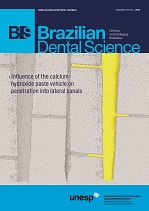Effect of different impression methods and ceramic materials on adaptation of inlays
DOI:
https://doi.org/10.14295/bds.2018.v21i3.1543Resumo
Objective: The aim of this study was to evaluate the internal and marginal adaptation of inlays fabricated from different types of impressions (conventional and digital) and different ceramics (feldspathic and lithium disilicate). Material and Methods: Forty premolars were prepared for all-ceramic inlay restoration and assigned to 4 groups (n=10), according to the impression method (conventional with addition silicone and digital impressions) and ceramic type (lithium disilicate and feldspathic ceramic blocks). For each type of impression, 10 inlays were fabricated from lithium disilicate blocks and the other 10 from feldspathic ceramic blocks, by means of the CAD-CAM system. The internal adaptation was analyzed by replica. The marginal fit was analyzed under a stereomicroscope by directly measuring the gap formed between the inlay and the tooth in the proximal and occlusal regions. Results: The marginal or internal adaptations were not affected by type of impression (conventional = digital impression), irrespective of the ceramic type. Only the internal adaptation was affected by material, i.e., feldspathic ceramic had lower values than disilicate ceramic, when considering the digital impression. Conclusion: The conventional and digital impressions promote similar marginal and internal adaptation of tested feldspathic and disilicate ceramic inlays. For digital impression the feldspathic ceramic showed better internal adaptation than lithium disilicate.
Keywords
Ceramics; Dental internal adaptation; Dental marginal adaptation; Dental impression technique.
Downloads
Downloads
Publicado
Como Citar
Edição
Seção
Licença
TRANSFERÊNCIA DE DIREITOS AUTORAIS E DECLARAÇÃO DE RESPONSABILIDADE
Toda a propriedade de direitos autorais do artigo "____________________________________________________________________" é transferido do autor(es) para a CIÊNCIA ODONTOLÓGICA BRASILEIRA, no caso do trabalho ser publicado. O artigo não foi publicado em outro lugar e não foi submetido simultaneamente para publicação em outra revista.
Vimos por meio deste, atestar que trabalho é original e não apresenta dados manipulados, fraude ou plágio. Fizemos contribuição científica significativa para o estudo e estamos cientes dos dados apresentados e de acordo com a versão final do artigo. Assumimos total responsabilidade pelos aspectos éticos do estudo.
Este texto deve ser impresso e assinado por todos os autores. A versão digitalizada deverá ser apresentada como arquivo suplementar durante o processo de submissão.




























